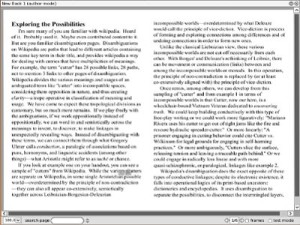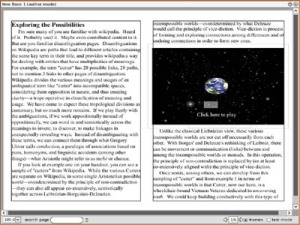V
As should be indicative from the play at work so far, I will follow a rhetoric more akin to Vitanza’s Sub/Versive Sophistic Rhetoric (a.k.a. the Antibody Rhetoric), and work to counter the infection of the philosophical tradition on Rhetoric (and the septinium in general).* Additionally, this is a move from the “old” rhetoric—Aristotle’s influenza with a focus on persuasion—and even a move from the “new” rhetoric—Kenneth Burke’s influence with a focus on identification—and instead a drifting in Jean François Lyotard’s paralogism, with a focus on instabilities, marginalia (marginals), de/stabilization and dis/placements, among other (sub/verting or perverting) connections.
We must, then, as Jacques Derrida tells us in “Inventing the Other,”** work to “unsettle the givens,” to subvert the anticipated conventions*** of this work:
It is certainly expected of a discourse on invention that it should fulfill its own promise or honor its contract: it will deal with invention. But it is also hoped (the letter of the contract implies this) that it will put forth something brand new—in terms of words or things, in its utterance or its enunciation—on the subject of invention [….] To however limited an extent, in order not to disappoint its audience, it ought to invent. We expect that it state the unexpected. (315)
But we must also keep in mind that we are not only pursuing a discourse on invention but also that we are (or should be) working in terms of invention—that is, the occurrence of invention—with the singular (unique) structure of an event that
seems to produce itself by speaking of itself, by the fact of speaking of itself, once it has begun to invent on the subject of invention, paving the way for it, inaugurating or signing its uniqueness, bringing it about, as it were, at the same moment as it also names and describes the generality of its genre and the genealogy of its topos: de inventione, sustaining our memory of the tradition of a genre and its practitioners. (317)
Therefore, this subversive, counter-inventional rhetoric must “write the paradigm“**** or, to follow Gregory Ulmer’s approach in Heuretics: The Logic of Invention,***** this inventional rhetoric must “use the method that I am inventing while I am inventing it, hence to practice hyperrhetoric” (17).
Immediately below you will find * notes, but you are also encouraged to scroll and read Comments, specifically my first comment as it indicates some of the issues this blog-post shift is trying to open. Then feel free to return (eternally return) to the Sophie Dissertation.
NOTES:
* This will help to move us from rhetoric based on intersubjectivity (Aristotle’s speakers/writers communicating to listeners/readers) to an approach based “on intertextuality, with the ‘desire’ of language itself more so doing the speaking/writing” (“Critical Sub/Versions” 53).
** It is important we note that this text (“Inventing the Other”) begins with a question, “What am I going to be able to invent this time?” which he repeats again several pages in. This repetition, perhaps marking a fold, enfolds another beginning in this text, which is where Derrida begins with a question of the son, borrowing from Cicero’s Partitiones oratoriae, where the son asks the father (Cicero) to tell him of invention (among the other great arts of the doctrine of speaking), but to do so in Latin and not Greek. Derrida is not a fool; this is as much of a vital component to the rest of this text as anything else in the text. At the outset, he couches us in the frame of the question of the son (whose “burning desire,” Derrida tells us, “anticipated the father’s wish” of the son being “as learned as possible” [313]) and in the language of Latin, which has issues in its translation of Greek—specifically important is the translation of aletheia into veritas. What we have then is a play, a subversion even, of the unfolding of this text.
*** In “Inventing the Other,” Derrida tells us, “An invention always presupposes some illegality, the breaking of an implicit contract; it inserts a disorder into the peaceful ordering of things, it disregards the proprieties. Apparently without the patience of a preface—it is itself a new preface—, this is how it unsettles the givens” (312)
**** This is the title Victor Vitanza uses in his review of Ulmer’s Heuretics, and it has significance both in terms of the Ulmer’s work and in terms of the previous quotes in the text from Derrida’s “Inventing the Other.” The contract of a discourse on invention is that one must invent something new, and to do that requires that the “newness” be created as it is being created—thus, to write on a new method, new approach, new genre, etc., nearly mandates the use of that method, approach, genre, etc. This also echoes the implications in this work, at least in reference to this dissertational other, this Sophie creation, as it is more akin to “writing the paradigm” than the print-literacy based creation. While Ulmer may have found a way to write the paradigm in literacy, as seen by his example mystory of “Derrida at Little Bighorn” (Teletheory 249-280), it is a bit difficult for us as the literacy version places us within a performative contradiction, which violates much of literate logic: while I am discussing, and will further explore, among others, the limitations of literate logoi, I am participating in literate logoi—doing the very thing that I am trying to resist; thus, the need, to work in a different paradigm, a digital paradigm.
***** Ulmer’s use of “the” vs. “a” in this work’s title (Heuretics: The Logic of Invention) implies a definitive restriction to the work itself and/or his intent, but I feel this is more accidental than purposeful—as the text itself, along with many other works by Ulmer, indicate that the restriction implied here (a definitive singularity) is not at all in keeping with his philosophies. This apparent accident can have numerous possibilities. Irony being one.

